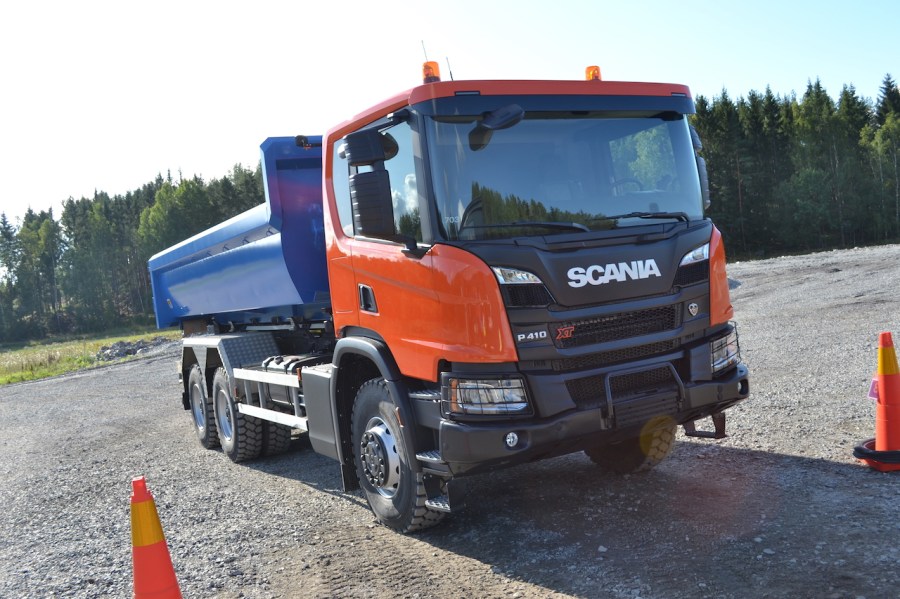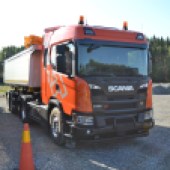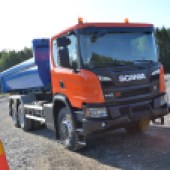The tough Scania XT range takes aim at construction applications. We test drive two new P410 XT and G500 XT models.
Scania took the wraps off its new XT range of chassis in August and is targeting it squarely at hauliers operating in arduous conditions. The XT designation is available across the Swedish manufacturer’s S-, R-, G- and new P-series cabs and brings the fight to the likes of Volvo’s robust FMX series, Renault’s Range K construction chassis and Iveco’s TRAKKER off-roaders.
Scania reckons a total of 19 possible cab combinations are on offer, meaning even the most finicky of operators should be able to find a suitable option.
XT can be spec’d with any of the manufacturer’s current line-up of Euro 6 engines, including V8s. They can also be fitted with Scania’s new Opticruise automated transmission with Clutch on Demand, which is a three-pedal set-up to give fine clutch control back to the driver should he or she require it (for example, when operating on loose surfaces).
XT models sport all-new heavy-duty steel bumpers which extend either 40 or 150 mm from the front of the cab with an improved approach angle, and reinforced ribbed rear-view mirrors to protect against accidental impact. Headlight clusters have also been bolstered with a steel cage to reduce damage from stones and other construction site hazards.
The bumper incorporates a towing pin behind the hinged numberplate, which Scania reckons has been certified to handle 40 tonnes to ensure the truck can be pulled – or pull other stranded vehicles – out of trouble if traction is lost on difficult terrain.
Drivers in mind
Cab entry and exit has received some attention. XT chassis have slip-proof steps, with the bottom step hanging on a rugged rubber hinge to enable it to soak up impacts without damage while the truck is going about its business.
In addition, operators can forgo an outside locker on some cab models in favour of an additional step mounted in the cab wall behind the door, affording drivers another foothold should they need to climb up to reach the top of the body. This is coupled with extra grab handles at the top of the doorframe and on top of the cab for extra safety.
Inside the cab, XT has branded seats and high-edge rubber mats to keep mud, water and detritus from dirty boots well contained. We also noticed the XT logo is projected onto the ground when the cab doors are open, which is easy to see in the dark – another nice touch.
Scania is also fitting an improved night lock system to XT to boost security when drivers are parked up. The system uses an articulated grab arm that can be pulled out from its door recess and clipped onto the grab handle, making the door impossible to open from the outside. Simple, elegant and effective.
In addition to its model-specific elements, XT also incorporates features being introduced to all Scania construction vehicles. These include EBS in combination with disc or drum brakes, several suspension systems including a new option of 2x 33 mm parabolic leaf springs; large and flexible wheel housing; and vertical exhaust stacks with two possible positions to keep dust-clogging to a minimum.
An electronic handbrake can also be specified, along with an enhanced hill hold facility which remains engaged for as long as the driver requires, instead of automatically releasing after four or five seconds.
On the road
Soon after the new range was announced, we were offered a drive in a variety of XT chassis at Scania’s HQ in Södertälje, Sweden. The first one we got to try was a 26-tonne P410 XT 6×6 hook-lifter with Low cab, which was designed to take a beating fitted with a six-speed automatic Allison transmission for continuous six-wheel drive.
The Low cab makes for easy entry and exit, though we found the high driving position provided better visibility. Direct vision has been improved thanks to a slight forwards and sideways shift of the driving position, similar to that seen in the manufacturer’s other new cabs, which combines with a lower dashboard and windowsills and smaller, narrower A-pillars to reduce potential blindspots.
Overall, we found visibility to be very good – it felt a bit like sitting in an aquarium.
The truck was riding on leaf springs with mechanical cab suspension, which gave plenty of ‘feel’ as we negotiated our way around the narrow roads and tight bends of Scania’s new off-road demo track. For sticky situations, the differential can be locked on the fly to provide a welcome traction boost – though since the weather was so dry on the day of our test, we didn’t need it.
Next up, we hopped into a G500 XT 6×4 rigid loaded with gravel. This truck featured Scania’s upgraded Opticruise automated transmission with layshaft brake and the new Clutch on Demand system, which we were encouraged to try out on a part of the track which had a particularly loose surface.
We found the biting point quite high, though the pedal did provide an extra bit of fine control. However, with the Opticruise set to ‘off-road’ mode, we reckon the automated ’box does the job well enough on its own and we wonder how much benefit the third pedal really provides. That said, it might win over a few dyed-in-the-wool drivers who still prefer manuals over auto ’boxes for tipper work.
VERDICT
With the construction industry booming, Scania’s introduction of a dedicated range of toughened off-road chassis is certainly timely. With the option of specifying any cab and engine combination, hauliers should be able to configure the exact truck to meet their needs regardless of their operation. But aside from flexibility, XT offers a host of carefully thought-out details designed to make the driver’s life easier and the operator’s less stressful. Indeed, with a boasted three per cent increase in fuel efficiency for construction ops, XT is a particularly viable off-road contender.
More information: https://www.scania.com/uk








